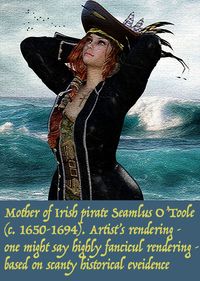
By Dr. Padraig Finagle (reprinted by kind permission)
Séamlus O'Toole (c. 1650 - 1694) is the most famous Irish pirate in maritime alternative history. Little is known of his origins beyond a vague reference in a mid-15th century Irish tavern ledger, discovered in university archives at Dublin in 1984. The entry appears to identify his father as being a sailor (name unknown) who skipped out on his reckoning, and his mother a tavern "strumpet" whom he failed to pay for services rendered, thus losing the landlord his cut, and gaining the lady a son.
Historical Record
Very little can actually be historically verified about O’Toole, as he was so secretive and highly adept at vanishing without witnesses, from his sudden onset in 1688, until the Maid O' Cadiz incident in 1694, about which more later. However, he was, apparently, actively engaged in piracy on the high seas during those years, which fall within the so-called "golden age of piracy". Why historians of that era have been universally silent about him is one of the many great mysteries of the sea.
The first known historical artifact that alludes to his name is a crew manifest of the Bess Millie from 1660, which shows the young Séamlus logged aboard as Cabin Boy at the Irish port of Baltimore, giving his age as 10 years, and noting his indenture to "repaye certain debtes" of his prostitute (implied) mother, whose age by this time apparently precluded creditors from accepting other forms of payment.
Nothing more surfaces in the historical record until 1674, when the log of the English merchant vessel Inda Boggs was washed ashore with other flotsam on the south-west coast of Ireland in late November of that year. The last page of the log bears a mostly illegible entry, dated March 17, which nonetheless provides a significant historical clue:
| [illegible…] Captin and mayte dedd of strange maladie, [blots] cursed simly, G.R.H.S. [splotches] Secund mayte S. Otoole [faded blots] cudgel [illegible blur] basturd [faded scrawl] vessile now commandeth. |
From amidst the many illegible blots, splotches and blurs, one can glean the following:
Captin and mayte dedd of strange maladie... cursed simly, G.R.H.S. (obviously "God Rest His Soul")... Secund mayte S. Otoole... cudgel... basturd (misspelled)... vessile now commandeth".
Maritime historians with nothing better to do speculate that O'Toole, an ordinary seaman risen evidently to a second mate’s berth, when unexpectedly finding himself in command, was unable to resist making off with the the ship and its cargo, disappearing until the loot was spent, to reappear as "a bloodie newe redd Irishe pirate" in 1688.
 ABOUT THE AUTHOR:
ABOUT THE AUTHOR:
Padraig Finagle is Ass. Professor of Alternative History and Brewing at the Auxiliary Maritime Institute and Public House of Skibbereen, Ireland. He holds an MBA (Master of Brewing Ales) from Boozer University, Kilkenny Ireland and is a fellow of the Guinness Institute, from which he holds an honorary D.D.T. (Doctor of Delirium Tremens).
